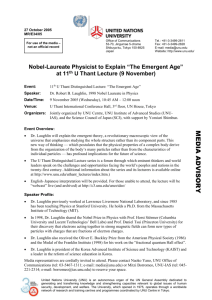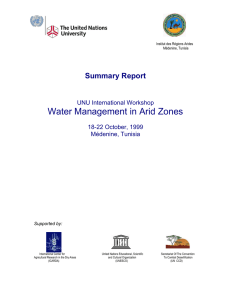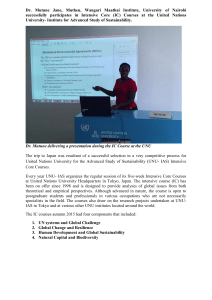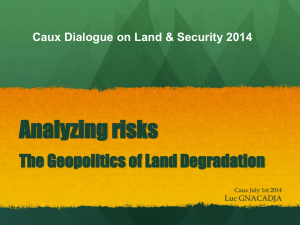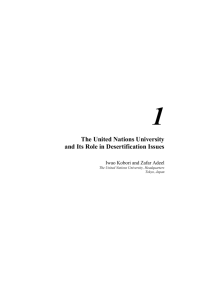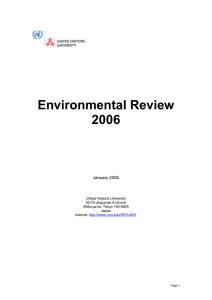Integrating land management in dry areas
advertisement
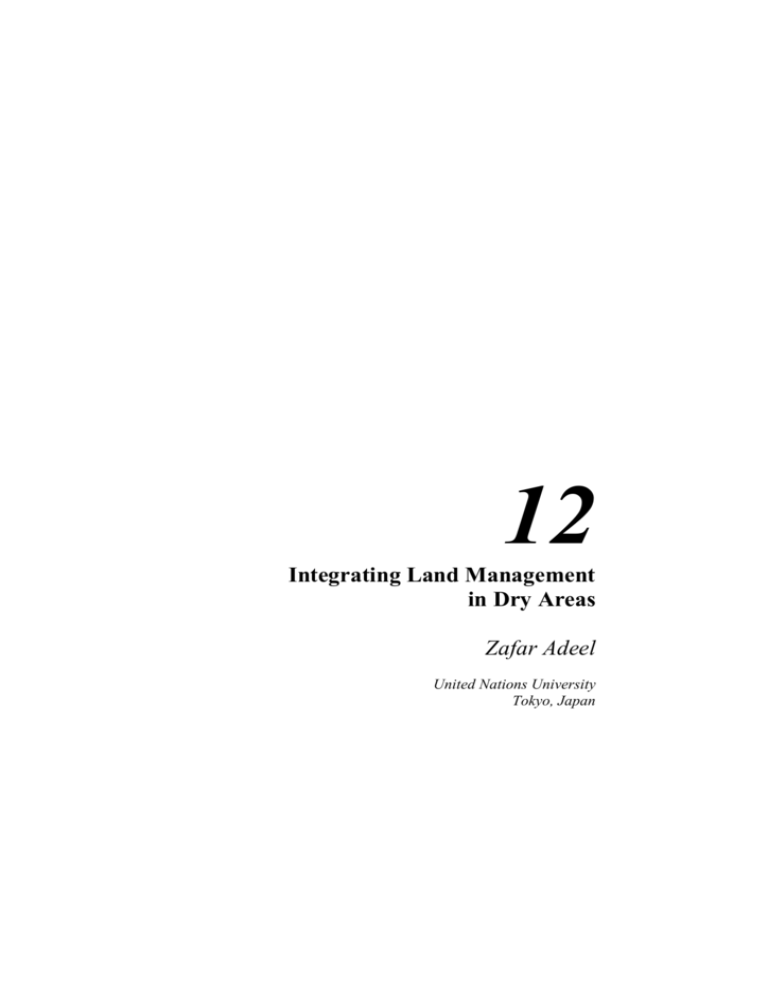
12 Integrating Land Management in Dry Areas Zafar Adeel United Nations University Tokyo, Japan 140 Adeel Land Degradation as a Global Problem L and degradation is defined as a process that leads to reduction the productivity of land for useful purposes and is typically a result of soil erosion, wind erosion, water erosion, soil salinization, waterlogging, chemical deterioration, or a combination of these factors. Land degradation is a global problem where marginal lands are turned into wastelands and natural ecosystems are destroyed. The immediate causes include deforestation, poor management of water resources, inappropriate land use practices, overuse of chemicals, fertilizers and pesticides, and disposal of domestic and industrial wastes. The underlying driving forces include rapidly increasing population, economic policies that over-exploit natural resources, and rapid and often poorly managed industrial and urban development. The impacts of land degradation are severe on both the human society and ecosystems. The UN estimates that some 70 per cent of the 5.2 billion hectares of drylands used for agriculture around the world are already degraded (UNEP, 2000). This impacts approximately 250 million people across the world – some estimates cite number of people at risk as being four times higher than this. As an example, the worldwide area of arable land per person has reduced by as much as 25% during the last quarter of the twentieth century. This has serious implications for food security and livelihood of people dependent on degraded lands. The impact of land degradation on ecosystems is apparent in destruction of biodiversity resources. According to UNEP estimates, about 65 million hectares of forest were lost globally during just five years between 1990 and 1995 (UNEP, 2000). The resultant loss in biodiversity at genetic, species and community level is also severe. These projections demand the attention of the international community and a coordinated effort to overcome these challenges. Integrated Land Management Approaches The most vulnerable areas in any ecosystem are the ones at its periphery. Most of the land erosion, degradation of soil quality, loss of biodiversity, and eventual loss of productivity occurs in these marginal – but high-priority – lands. This is particularly true Integrating Land Management in Dry Areas 141 for “Dry Areas”, those comprising arid, semi-arid and dry subhumid regions. Sustainable management strategies in these dry areas are needed for protection, preservation and reclamation or rehabilitation in these fragile systems and natural resources contained therein. Such strategies are closely linked to human development and quality of life in these marginal areas. Development of integrated approaches is critical to minimizing land degradation and the related societal and economic impacts. There is a need to promote actions for building and strengthening existing institutional capacities for regional, national and basin-level agencies to effectively address and integrate cross-sectoral aspects. However, defining such integrated approaches is a complex job and the outcome would vary from region to region. In order to develop a general framework for such integrated approaches, there four key dimensions of the problem, as shown in Figure 1, that must be considered. Technical Dimensions Human Dimensions Economic Dimensions Natural Resources Dimensions Figure 1. Key dimensions of the integrated approaches to land management. 142 Adeel A. Technical Dimensions: All renewable natural resources (water, soil, vegetation, etc.) should be taken into account when developing integrated management programs; Innovative solutions have to be identified for managing land degradation, mainly through water use efficiency and productivity, and soil conservation; Potential conflicts and synergies between highlands and lowlands should be given due consideration, particularly because highlands and mountains serve as water towers for the lowlands; and Due consideration be given to trans-ecozone characteristics of resources – especially water. Planning and conflict resolution on a trans-ecozone level become crucial in approaches to improve the resources situation in dry areas. B. Human Dimensions: Localized approaches for land ownership and land tenure are often critical in conservation of resources; Impacts on livelihood of local people need to be accounted for when designing and discussing resource management approaches; alternative livelihoods for communities that may be impacted have to be developed; Effects of indigenous practices on natural resources, both positive and negative, should be accounted for; Whenever applicable, indirect social benefits of integrated management should be explicitly considered; and Mechanisms for conflict resolution during the implementation of management approaches should be built into the programmes. C. Economic Dimensions: Evaluation of social, environmental and economic costs and benefits has to be undertaken to ensure long-term sustainability or viability of integrated approaches; Capital investment into developing new infrastructure as well as maintaining existing and traditional practices should be made; and Linkages to national economic development should be elaborated. Integrating Land Management in Dry Areas 143 D. Natural Resource Dimensions: Rehabilitation of ecosystems in marginal lands should have the highest priority in integrated programmes; and Whenever applicable, in situ conservation of biodiversity within ecosystems should be considered. These dimensions are closely interlinked with each other and need to be considered explicitly to develop fully integrated approaches. A number of international organizations are already working towards development of such approaches; although successful examples of such programmes are few. Development of a UNU Project on the Subject In consideration of the multi-dimensional challenges, UNU has undertaken the development of a project framework. With the view that this project is focused on developing countries in dry areas – particularly the region comprising Northern Africa, Central Asia, Middle East and China – the following objectives are identified: To facilitate development of integrated management approaches for sustainable utilization of natural resources, including land, water and biodiversity resources in marginal lands; Identify key research areas in land and natural resource management that can benefit the most from capacity building; Develop appropriate capacity building programmes, with emphasis on south-south collaboration for transfer of environmentally-sound technologies; and Catalyze development of networks of researchers and institutions working in various disciplines and geographical settings. Project Framework The project will be implemented through a network of researchers and institutions. It will comprise various sub-projects implemented through the partners within the network. Institutional collaborations with other international organizations working on similar issues will also be sought. 144 Adeel Project Priority Areas The project seeks to develop integration across disciplines and vertically between governance and land management. To achieve integration at these various levels, a subset of priority areas have been identified: Assessing threats to marginal lands, which can be achieved through quantifying threats to water, land and biodiversity resources; Development of assessment maps to identify areas under high level of stress and threats to natural resources; Evaluation of land productivity, considering temporal changes in land use and land cover, and identifying their causes; Comparative evaluation of land management approaches in the region, with the objective of sharing results and transfer of environmentally-sound technologies; Identification of correlation with other regimes such as climate change and biodiversity conservation, for example, through evaluating carbon sequestration capacity as a result of integrated land management. Project Elements A project within the network must contain four elements to ensure that the results and benefits of the project are fully transferred to the communities or target audience. These elements are in accordance with UNU’s objectives and utilize its existing institutional strengths. Network Development: This can be achieved through meetings and workshops followed up by publications and Internet communication. The main purposes are to enhance information exchange and identify the specific research needs of marginal lands in terms of capacity building. Development of Training Programmes: Based on the needs identified during network development, training programmes with well-defined objectives and target audience should be developed. These training programmes may also include development of training materials such as textbooks, workbooks, manuals, CD-ROMs. Integrating Land Management in Dry Areas 145 Research on Integrated Land Management in Marginal Lands: This targeted research work should emphasize the importance of integrated management of water and land resources and identify methodologies/techniques that are environmentally-sound. Dissemination of Environmentally-Sound Information: Because UNU focuses on a south-south collaboration, an important part is to share the project results as well as information on technologies that have been successfully applied in the developing countries. Quality Criteria For projects to affiliate with the UNU project, some basic criteria must be met. These criteria can be considered as quality criteria for the projects and should include the following: The project must provide integration of disciplines and approaches; The group undertaking the work must be multidisciplinary in its composition, involvement of NGOs and experts in traditional technologies should be considered; The scientists in the group must be recognized in their respective field for quality of their research work; There should be clear prospects of continuity and sustainability of the project itself; The research work must include explicit mechanisms for transferring the knowledge and expertise to local communities and target groups. On the whole, the project implementation and selection of subprojects is overseen by a Steering Committee. The network within the project is maintained and expanded through a series of workshops, held annually. These workshops focus on various dimensions of a selected subject area and geographical region (please see the UNU Desertification Series: UNU, 1998; and UNU, 1999). Dissemination activities will include publication of workshop proceedings and preparation of other project materials. 146 Adeel References UNEP, 2000. Global Environment Outlook 2000, UNEP’s Millennium Report on the Environment, Earthscan Publishers, United Kingdom. UNU Desertification Series, 1998. New Technologies to Combat Desertification, Proceedings of the International Symposium held in Teheran, Iran, 12-15 October 1998, Environment and Sustainable Development, UNU, Tokyo, Japan UNU Desertification Series, 1999. Water Management in Arid Lands, Proceedings of the International Workshop held in Mednine, Tunisia, 18-22 October 1999, Environment and Sustainable Development, UNU, Tokyo, Japan.
